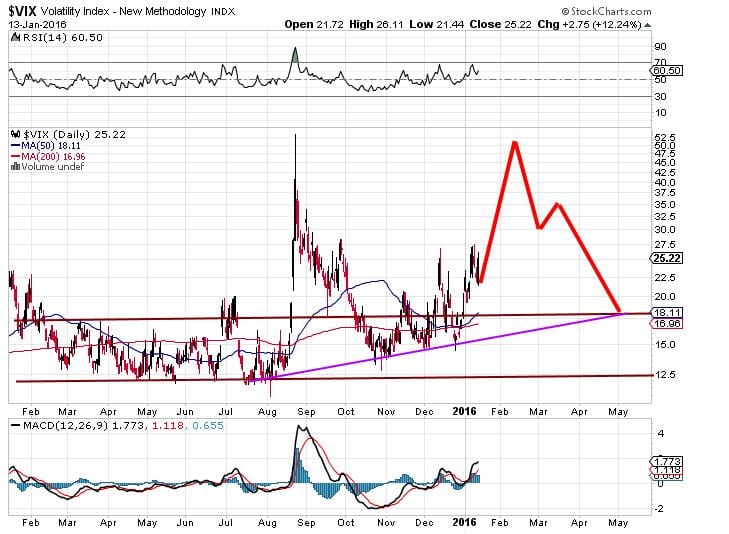
Harnessing the Power of the VIX Fear Indicator: A 2016 Case Study
Updated Feb 12, 2024
The VIX fear indicator, a widely recognized measure of market volatility, has proven to be a valuable tool for investors seeking to navigate the unpredictable waters of the financial markets. This article will provide a historical overview of how this tool could have been used effectively in 2016, offering real examples to illustrate its application.
Throughout 2016, the financial markets experienced heightened levels of volatility, presenting both challenges and opportunities for investors. By analysing the performance of the VIX fear indicator during this period, we can gain insights into its potential as a guiding tool for investment strategies.
This case study will investigate specific instances where the VIX fear indicator provided actionable insights. We will highlight key moments when the indicator exhibited notable spikes or declines and examine how these movements correlated with market trends and events. By exploring these real-life examples, we aim to demonstrate the practical application of the VIX fear indicator and showcase its potential to guide investment decisions.
Understanding VIX: A Key to Navigating Market Volatility
By retrospectively analysing the VIX fear indicator’s behaviour in 2016, investors can learn valuable lessons and gain a deeper understanding of its dynamics. We will showcase how the indicator could have been utilised to identify optimal entry and exit points, navigate periods of heightened volatility, and capitalise on potential market downturns or upswings.
This historical overview aims to provide readers with a comprehensive understanding of the VIX fear indicator’s utility and relevance in managing risk and seizing opportunities. By examining real examples from 2016, we hope to equip investors with valuable insights that can inform their decision-making process in the future.
As we embark on this journey through the market landscape of 2016, let us explore the power of the VIX fear indicator and uncover the valuable lessons it offers to investors seeking to navigate volatile market conditions.
Examining Real-Life Examples: Utilizing the VIX Volatility Gauge in 2016
Which one would you rather play: a correction that begins and ends suddenly, giving you little time to react, or a nice upward move that lasts four times as long and ample time to jump in or out? We are not making this up. Look at the chart below and a diagram of the Dow, Russell, NASDAQ or SPX. After that, you will see that market bottom when the VIX spikes upwards. Extreme readings in the VIX always correspond to market bottoms. The market either bottoms immediately or shortly after the VIX experiences a massive upward surge.
Fear is a natural response in flight or fight situations, but the financial markets don’t fall into that category. You need to go against your instincts. Fighting or fleeing from market trends isn’t the way to go. Even when shorting the markets, decisions should be calm and collected, not driven by fear or dread. This principle aligns with Mass Psychology and Contrarian investing.

Decoding the Volatility Index: Unraveling Market Volatility
We have outlined roughly the path we expect the VIX to trace. We view a potential upward spike in the VIX as an opportunity, and so should you. History indicates that the VIX always trends downwards after surging upwards. Lower VIX readings are associated with higher market prices.
The trend in the SPX is neutral, and when coupled with the highly high V readings, it confirms the statements we made in Dec of 2015: extreme volatility is here to stay. Always remember that volatility is a two-sided equation, and we believe the moves to the upside will be even larger than those to the downside.
For the past several months, we have stressed that V readings are pointing to much more volatility as we advance, and that has been the case. The latest reading pushed this index into the all-time new high territory, and as we stated at the beginning of this update, 2016 will redefine the meaning of the word volatility. Expect the extreme of extremes everywhere: wild market swings, wild climate swings, unbalanced human behaviour all over the world (sudden surges of violence followed by equally sudden moments of calm), etc.
Embracing Volatility with the VIX Fear Indicator
Volatility is a two-sided equation. While it can lead to market downturns, it can also result in upswings. The VIX fear indicator can help investors navigate these periods of heightened volatility and capitalise on potential market downturns or upswings 3.
For instance, history indicates that the VIX always trends downwards after surging upwards. Lower VIX readings are associated with higher market prices. This suggests that potential upward spikes in the VIX can be considered opportunities for investors.
In 2016, the trend in the SPX was neutral, and when coupled with the highly high V readings, it confirmed that extreme volatility was here to stay 3. This volatility presented both challenges and opportunities for investors. By treating volatility as a friend and capitalising on stronger deviations or pullbacks, investors could achieve fruitful outcomes.
Throw fear out the window and understand that you must treat volatility as your friend this year. The stronger the deviation/pullback, the better the opportunity; that is what your mantra should be for this year. This outlook will remain valid if the trend is up or neutral. We will stick our necks out even further and state that we expected the Dow to trade in the 18,800-19,000 range in 2016; this view will remain valid unless the trend turns negative. Market update Jan 2, 2016
Unless the trend turns negative, we still adhere to the above viewpoints. Our trend indicator is what we follow; as of now, it is not showing any signs of moving into the sell zone.
Conclusion:
In conclusion, the VIX fear indicator is valuable for investors, highlighting the importance of not succumbing to panic. History shows that the VIX tends to trend downwards after surging upwards, indicating that lower VIX readings are associated with higher market prices. By recognising that volatility can be embraced as a friend rather than feared, investors can seize opportunities presented by potential upward spikes in the VIX.
With the trend in the SPX being neutral and extreme volatility expected to persist, treating volatility as a friend and capitalising on stronger deviations or pullbacks can lead to fruitful outcomes. As long as the trend remains positive or neutral, investors should view volatility as a friend and stay mindful of the trend indicator to guide their investment decisions.



